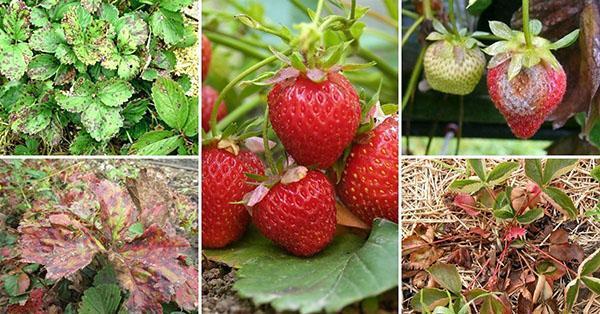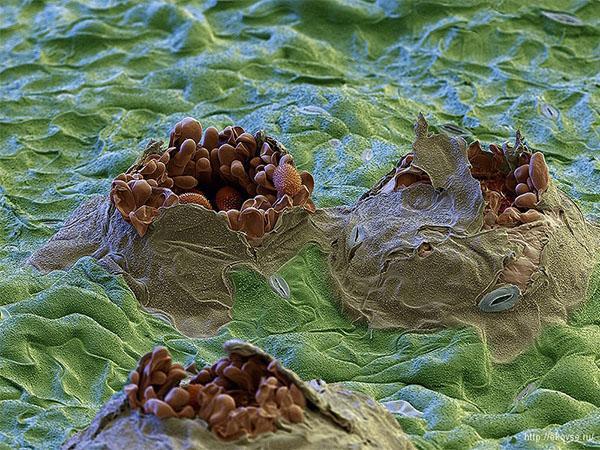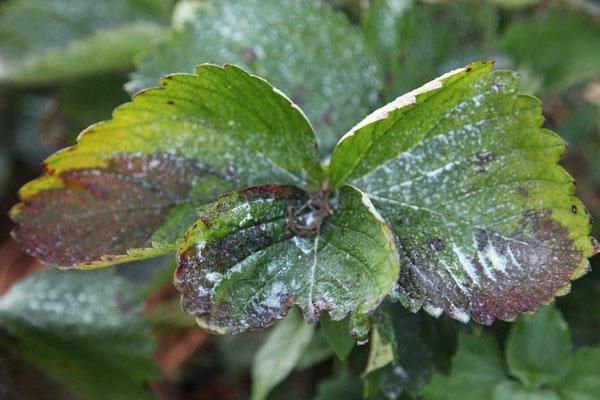We study strawberry diseases and how to deal with them
 The fragrant and unusually tender berry is one of the first harbingers of the summer extravaganza. Still, gardeners are frustrated by the fact that strawberry and strawberry diseases often destroy a rich harvest. It is possible to save your lands from invisible pests! One has only to take a number of competent actions. Especially when the first signs of the most common ailments of culture appear.
The fragrant and unusually tender berry is one of the first harbingers of the summer extravaganza. Still, gardeners are frustrated by the fact that strawberry and strawberry diseases often destroy a rich harvest. It is possible to save your lands from invisible pests! One has only to take a number of competent actions. Especially when the first signs of the most common ailments of culture appear.
Weather plays a huge role in the active development of diseases. If it is damp and cool outside the window, and buds are tied in the garden, then this should be a serious cause for excitement. During this period, it is necessary to especially carefully monitor the plant, since small specks on the foliage can tell a lot.
It should be borne in mind that harmful microorganisms progress under certain conditions. Therefore, the task of the gardener is to prevent their occurrence.
Determine diseases of strawberries / strawberries by color

Brown or black
 Most often, symptoms of brown spot appear in the middle of summer. Petioles, tendrils, and leaves on strawberries turn brown and dry. The process takes place in several stages:
Most often, symptoms of brown spot appear in the middle of summer. Petioles, tendrils, and leaves on strawberries turn brown and dry. The process takes place in several stages:
- first, areas of a reddish hue appear on the bush (they differ in an angular or irregular shape);
- over time, the spots darken;
- later, the entire surface is covered with black dots, from which mucus oozes;
- as a result, the foliage fades and dries up completely.
On the petioles and antennae, the spotting has a completely different character. It is presented in the form of small impressed black blotches. The causative agents of such ailments are fungal spores. Their distribution is facilitated not only by insects, but also by wind and rain.
Brown spotting is much more difficult at the end of the season. After all, it seems that the culture is preparing for wintering. However, it is worth carefully examining all parts of the plant and looking for dangerous signs. As a result, she will safely survive the winter.
Other hazards
 Similar symptoms can be observed in completely different strawberry diseases. Only in this case, everything starts with yellowing of the corners of the leaves. As time passes, the edges become rough with a brownish tint. The spots begin to take on an angular shape. However, the yellow border still exists. After rain, a slimy mass appears on the affected areas, which is a breeding ground for bacteria. Among the main reasons why strawberry leaves turn black, it is necessary to indicate:
Similar symptoms can be observed in completely different strawberry diseases. Only in this case, everything starts with yellowing of the corners of the leaves. As time passes, the edges become rough with a brownish tint. The spots begin to take on an angular shape. However, the yellow border still exists. After rain, a slimy mass appears on the affected areas, which is a breeding ground for bacteria. Among the main reasons why strawberry leaves turn black, it is necessary to indicate:
- waterlogging of the soil;
- dense planting of individual specimens;
- active influence of weeds.
Late blight manifests itself in the same way, but it also affects berries. They become tough, at the same time acquire a bitter taste, and in the end they completely rot.
Dry and yellowed deciduous plates indicate a lack of nitrogen-containing compounds. To restore natural balance nitrogen in the ground, add ammonium nitrate: 25 g per 10 liters of water.
Protection methods
 Brown spot often does not respond to treatment. They try to completely remove the affected greens from the plant and burn them. After that, the soil is processed bordeaux liquid (3%).The remaining foliage is sprayed with copper sulfate or preparations that include copper compounds. Among other things, the following should be added to the soil:
Brown spot often does not respond to treatment. They try to completely remove the affected greens from the plant and burn them. After that, the soil is processed bordeaux liquid (3%).The remaining foliage is sprayed with copper sulfate or preparations that include copper compounds. Among other things, the following should be added to the soil:
- wood ash;
- potassium and phosphate complexes, which increase the immune system of the culture;
- crushed laundry soap.
In the spring, prophylactic spraying against viral / fungal pests is carried out. Every 10 days, the area is treated with an iodine solution (1 ml per liter of liquid).
Disease and treatment of strawberries is a very responsible matter. Often the reasons lie in the roots of the plant. Therefore, experts recommend changing the mulching cover every year. It can rot and become a breeding ground for bacteria / fungi. Removing dried leaves as well as tendrils is an excellent prevention against spotting.
When buying seedlings, they are carefully examined. Some of them may already be amazed.
Peduncles under threat
 Many are interested if there is blackness in the flower on Victoria, how to process the bush? First, you should find out the reasons for its occurrence. Darkening of the middle is a consequence of the habitat of pests, in particular, weevils. Since spring, the bugs lay eggs in the flower, and then the larvae begin to actively eat the greens. You can protect a crop from an insect in this way:
Many are interested if there is blackness in the flower on Victoria, how to process the bush? First, you should find out the reasons for its occurrence. Darkening of the middle is a consequence of the habitat of pests, in particular, weevils. Since spring, the bugs lay eggs in the flower, and then the larvae begin to actively eat the greens. You can protect a crop from an insect in this way:
- plant garlic, calendula, marigolds, onions, calendula or tomatoes in aisles;
- during the formation of ovaries, treat the bed with a solution of 9% vinegar (1 glass per bucket) or soda (2 tablespoons of powder per liter of liquid);
- spray the area with a solution of ammonia (dilute 2 tablespoons of substance in 10 liters) or tar (3-4 caps).
Favorable conditions for the appearance of spotting is a sharp drop in temperature. The ovaries darken at -2-3 ° C. Such outlets are completely removed. Among other things, it is recommended to cover the garden with high quality. For this, the aisle is covered mulch (sawdust), and then compact the snow cover. With the threat of frost:
- cover the strawberries with spunbond or foil;
- organize the smoke of the site (along the perimeter, heaps of hay / straw are laid out and set on fire, and to maintain smoking, raw moss or grass is placed on top);

- systematically watered, because during evaporation, the temperature above the soil surface rises.
When protecting the planting from frost, the film should be removed in time. For the reason that pollination does not occur under cover.
In this case, the main thing is to do everything in an owl time. The gardener must carefully monitor the weather in order to then cover the bushes with a canvas. Also, before the appearance of pests, treat peduncles with solutions.
Varieties of rot
Gray rot on strawberries is considered especially dangerous (potassium permanganate is prepared in a ratio of 5 g / 10 l). It is often almost impossible to get rid of mold. It affects more than 85% of the berries, thereby destroying a huge amount of the crop. The entire aboveground part of the culture suffers from the fungus. There are several types of rot:
- Black. Acts on roots or berries. Preventive measures: treatment of planting with boric acid (10 g of the drug is diluted in a bucket of water) or place seedlings exclusively in elevated places. The roots suffer when the crop grows for a long time in one place or is planted after potatoes, corn and tomatoes.

- White. Due to the dense planting and dampness, strawberries are covered with white fluff, and as a result, they rot. Therefore, young bushes are thinned out. At the same time, an elevated site is selected for the plant.

- Anthracnose. A purple border appears on the leaves. The stems are covered with gray dots, and brown rot appears on the fruits. It occurs when the soil is highly waterlogged.

- Gray. The fungus appears as a grayish coating. The fruit becomes watery. Reasons: damp and cool weather. Control: timely removal of contaminated greenery, thinning and straw mulch.

Spraying with chemicals is carried out at a temperature above + 10 ° C, as well as at a suitable time: before the formation of buds or after collecting the last fruits.
Strawberry diseases can be a disaster for the gardener. However, if you detect their manifestation in time, or even better take preventive measures, you can avoid such fatal consequences.